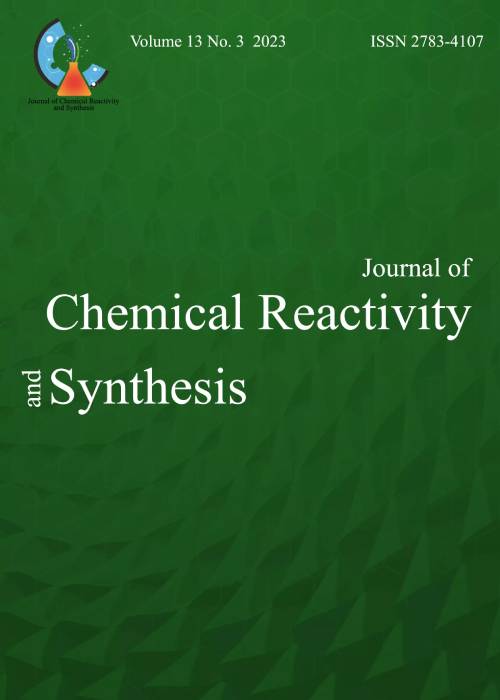فهرست مطالب
Journal of Chemical Reactivity and Synthesis
Volume:9 Issue: 1, Winter 2019
- تاریخ انتشار: 1397/02/18
- تعداد عناوین: 6
-
Pages 1-10
3-(2’-n-butylbenzofuran-3’-yl)-5-aryl-4, 5-dihydro-1H-pyrazoles (4a-4k) have been synthesized. The synthesized products have been assayed for their antimicrobial activity against Gram+ve, Gram-ve bacteria and fungi. All the synthesized products were assigned with IR, 1HNMR, Mass Spectra, TLC, and elemental analysis. Some of the products showed moderate activity, compare with known standard drugs.
Keywords: UTYLBENZOFURAN- PYRAZOLES- SYNTHESIS, Antimicrobial -
Pages 11-24
There is need to develop simple, efficient & economically viable chemical pathways to synthesise biologically active & commercially important heterocyclic Bis(indolyl) methanes1.The indole ring is an important constituent of many natural products, pharmaceuticals & other compounds of commercial importantance2. The literature survey shows that Bis(indolyl) methanes are known to increase estrogen metabolism in human beings and hence can be used for the treatment of breast cancer, also it exhibits antibacterial activities3,4,5. This wide range of applications has leaded the chemists to develop new methods to synthesise Bis (Indolyl) methanes. Various methods have been developed for their synthesis using Lewis acid catalysts6-12, ionicliquids13, trichloro-1,3,5-triazine14, and potassium hydrogen sulphate15.However, many of these reported methods suffer from one or other disadvantages such as harsh reaction conditions and reagents that are expensive, moisture sensitive. A mild and efficient catalyst for the synthesis of bis(indolyl) methanes is highly desirable.
Keywords: Bis(indolyl) methanes, CeO2 nanoparticles, carbonyl compounds, indole, Aldehydes -
Pages 25-40
By exposing to NaClO aqueous solution (commercial bleach), NiBr2 is transformed quantitatively into an insoluble nickel oxide hydroxide species. This compound contains large surface area and is a beneficial heterogeneous catalyst for oxidizing numerous organic materials. The oxidation of aldehydes and primary alcohols to carboxylic acids and secondary alcohols to ketones is showed with 1 mol % of NiBr2 catalyst and NaClO as the terminal oxidant. It is demonstrated that the controlled and selective oxidizing of numerous organic compounds with this system resulting in 55-95 % separation yields and 87-95 % purity. In most cases, the oxidations can be carried out with no organic solvent, causing this method attractive as a “greener” substitute to traditional oxidations.
Keywords: Heterogeneous catalyst, NaClO, NiBr2, Oxidation, Alcohols, Aldehydes -
Pages 41-59
In this research, Quantum-mechanical calculations were performed at the HF method with the 6-31+G*basis set and at the B3LYP method with the 6-31+G* basis set in the gas phase and five solvents such as water, DMSO, methanol, ethanol and dichloromethane at six temperatures. According to these theoretical results of IR, we extracted thermo chemical parameters such as enthalpy (∆H Kcal/mol), Gibbs free energy (∆G Kcal/mol) and entropy (∆S cal/molK). Important relationship have been found between solvent effect and structure of Calixarens with histidine L and D stereochemistry. Also, nuclear shielding parameters of Calixarene, such as chemical shift isotropic value (σiso) and the anisotropy shielding (σaniso, ∆σ), have been taken into account using GIAO method at the HF method with the 6-31+G* basis set and at the B3LYP method with the 6-31+G* basis set in the gas phase and in different solvents such as water, DMSO, methanol, ethanol and dichloromethane. The results were revealed that the NMR chemical shielding parameters are strongly affected by inducing different solvent media. According to these theoretical results,it can be drastically concluded that the dielectric permittivity of the solvent is a key factor that determines the chemical behavior of Calixarene with histidine L and D stereochemistry in solution. Also the natural bond orbital (NBO) analysis has been performed at the six levels in the gas phase and different solvent media which show some important atomic and structural features.
Keywords: Calixarene, IR, thermo chemical parameters, NMR chemical shielding parameters, NBO, gas phase, solvent effect -
Pages 60-66
An effective one-pot synthesis of dihydropyrimidinonoes in solvent free conditions using CuCl2 as an inexpensive and readily available reagent through Biginelli condensation reaction of aldehyde derivatives, 1,3-dicarbonyl compounds and urea is described. Excellent yields, short reaction times for formation of the products and simple work-up are attractive features of this green protocol.
Keywords: Biginelli reaction, Dihydropyrimidinones, One-pot, Solvent-free -
Pages 67-77
New 1,5-tetra alkyl methyl- phenyl-1H-pyrimido[4,5-e][1,3,4]thiadiazine-3,7-diamine were synthesized via the cyclocondensation of 2-(5-bromo-2-chloro-6-methylpyrimidin-4-yl)-2- methylhydrazine with phenylthioisothiocyanate and further replacement of chlorine atom on the seven number position of pyrimido[4, 5- e][1, 3, 4]thiadiazin by appropriate secondary amines in simple and efficient methods.
Keywords: heterocyclization, 5- bromo- 2, 4- dichloro-6- methylpyrimidine, 2-(5-bromo-2- chloro-6-methylpyrimidin-4-yl)-2-methylhydrazine, phenylthioisothiocyanate


